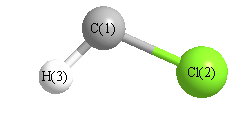Jump to
S2C1
Energy calculated at M06-2X/aug-cc-pVDZ
| | hartrees |
|---|
| Energy at 0K | -498.740525 |
| Energy at 298.15K | -498.740385 |
| HF Energy | -498.740525 |
| Nuclear repulsion energy | 38.560179 |
The energy at 298.15K was derived from the energy at 0K
and an integrated heat capacity that used the calculated vibrational frequencies.
Geometric Data calculated at M06-2X/aug-cc-pVDZ
Point Group is Cs
Cartesians (Å)
| Atom |
x (Å) |
y (Å) |
z (Å) |
|---|
| C1 |
0.046 |
1.198 |
0.000 |
| Cl2 |
0.046 |
-0.507 |
0.000 |
| H3 |
-1.047 |
1.422 |
0.000 |
Atom - Atom Distances (Å)
| |
C1 |
Cl2 |
H3 |
| C1 | | 1.7051 | 1.1155 |
Cl2 | 1.7051 | | 2.2168 | H3 | 1.1155 | 2.2168 | |
 More geometry information
More geometry information
Calculated Bond Angles
| atom1 |
atom2 |
atom3 |
angle |
|
atom1 |
atom2 |
atom3 |
angle |
| Cl2 |
C1 |
H3 |
101.564 |
|
Electronic energy levels
Charges, Dipole, Quadrupole and Polarizability
Charges from optimized geometry at M06-2X/aug-cc-pVDZ
Charges (e)
| Number |
Element |
Mulliken |
CHELPG |
AIM |
ESP |
| 1 |
C |
-0.133 |
|
|
|
| 2 |
Cl |
0.113 |
|
|
|
| 3 |
H |
0.020 |
|
|
|
Electric dipole moments
Electric dipole components in Debye
(What's a Debye? See section
VII.A.3)
| |
x |
y |
z |
Total |
| |
-1.416 |
-0.505 |
0.000 |
1.503 |
| CHELPG |
|
|
|
|
| AIM |
|
|
|
|
| ESP |
|
|
|
|
Electric Quadrupole moment
Quadrupole components in D Å
| Primitive |
|---|
| | x | y | z |
|---|
| x |
-19.712 |
-2.686 |
0.000 |
| y |
-2.686 |
-19.999 |
0.000 |
| z |
0.000 |
0.000 |
-18.376 |
|
| Traceless |
|---|
| | x | y | z |
|---|
| x |
-0.524 |
-2.686 |
0.000 |
| y |
-2.686 |
-0.955 |
0.000 |
| z |
0.000 |
0.000 |
1.480 |
|
| Polar |
|---|
| 3z2-r2 | 2.959 |
|---|
| x2-y2 | 0.287 |
|---|
| xy | -2.686 |
|---|
| xz | 0.000 |
|---|
| yz | 0.000 |
|---|
|
Polarizabilities
Components of the polarizability tensor.
Units are
Å
3 (Angstrom cubed)
Change units.
| |
x |
y |
z |
| x |
3.563 |
-0.108 |
-0.001 |
| y |
-0.108 |
5.550 |
-0.002 |
| z |
-0.001 |
-0.002 |
3.221 |
<r2> (average value of r
2) Å
2
| <r2> |
28.241 |
| (<r2>)1/2 |
5.314 |
Jump to
S1C1
Energy calculated at M06-2X/aug-cc-pVDZ
| | hartrees |
|---|
| Energy at 0K | -498.734135 |
| Energy at 298.15K | -498.733990 |
| HF Energy | -498.734135 |
| Nuclear repulsion energy | 38.749962 |
The energy at 298.15K was derived from the energy at 0K
and an integrated heat capacity that used the calculated vibrational frequencies.
Geometric Data calculated at M06-2X/aug-cc-pVDZ
Point Group is Cs
Cartesians (Å)
| Atom |
x (Å) |
y (Å) |
z (Å) |
|---|
| C1 |
0.037 |
1.160 |
0.000 |
| Cl2 |
0.037 |
-0.516 |
0.000 |
| H3 |
-0.844 |
1.801 |
0.000 |
Atom - Atom Distances (Å)
| |
C1 |
Cl2 |
H3 |
| C1 | | 1.6760 | 1.0893 |
Cl2 | 1.6760 | | 2.4784 | H3 | 1.0893 | 2.4784 | |
 More geometry information
More geometry information
Calculated Bond Angles
| atom1 |
atom2 |
atom3 |
angle |
|
atom1 |
atom2 |
atom3 |
angle |
| Cl2 |
C1 |
H3 |
126.016 |
|
Electronic energy levels
Charges, Dipole, Quadrupole and Polarizability
Charges from optimized geometry at M06-2X/aug-cc-pVDZ
Charges (e)
| Number |
Element |
Mulliken |
CHELPG |
AIM |
ESP |
| 1 |
C |
0.100 |
|
|
|
| 2 |
Cl |
0.101 |
|
|
|
| 3 |
H |
-0.202 |
|
|
|
Electric dipole moments
Electric dipole components in Debye
(What's a Debye? See section
VII.A.3)
| |
x |
y |
z |
Total |
| |
-0.694 |
0.525 |
0.000 |
0.870 |
| CHELPG |
|
|
|
|
| AIM |
|
|
|
|
| ESP |
|
|
|
|
Electric Quadrupole moment
Quadrupole components in D Å
| Primitive |
|---|
| | x | y | z |
|---|
| x |
-18.665 |
-1.454 |
0.000 |
| y |
-1.454 |
-17.053 |
0.000 |
| z |
0.000 |
0.000 |
-19.912 |
|
| Traceless |
|---|
| | x | y | z |
|---|
| x |
-0.182 |
-1.454 |
0.000 |
| y |
-1.454 |
2.235 |
0.000 |
| z |
0.000 |
0.000 |
-2.053 |
|
| Polar |
|---|
| 3z2-r2 | -4.106 |
|---|
| x2-y2 | -1.611 |
|---|
| xy | -1.454 |
|---|
| xz | 0.000 |
|---|
| yz | 0.000 |
|---|
|
Polarizabilities
Components of the polarizability tensor.
Units are
Å
3 (Angstrom cubed)
Change units.
| |
x |
y |
z |
| x |
3.267 |
-0.107 |
0.000 |
| y |
-0.107 |
5.248 |
0.000 |
| z |
0.000 |
0.000 |
3.229 |
<r2> (average value of r
2) Å
2
| <r2> |
28.168 |
| (<r2>)1/2 |
5.307 |
